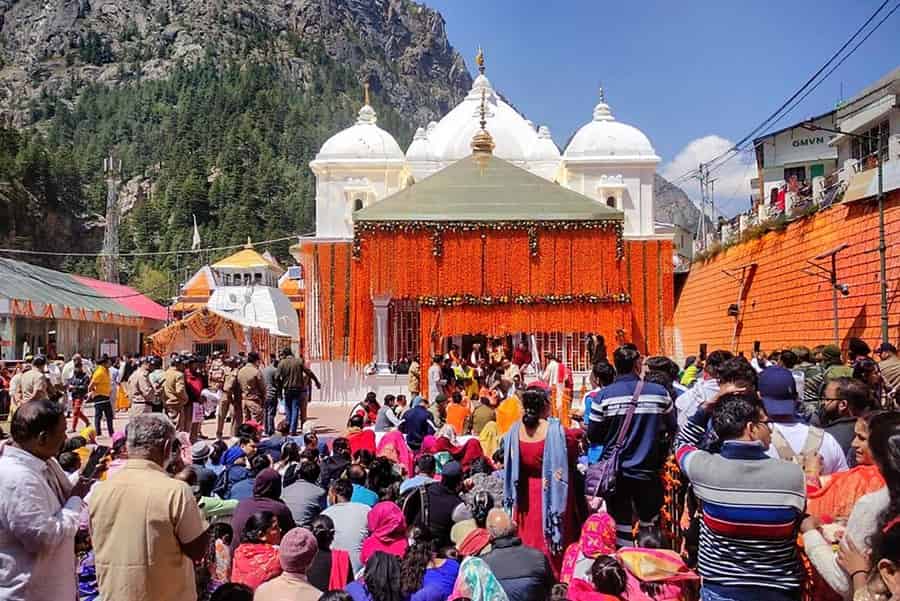Situated at an altitude of 3100 mts, Gangotri Temple in the Uttarkashi district of Uttarakhand will fine-tune your spirits from all the worldly chaos. It is one of the most prominent Hindu pilgrimage sites in India. The temple of Gangotri is a blissful realm of the river Goddess Ganga. Surrounded by enchanting Deodar and Pines in the rugged terrains of the Greater Himalayas, it is a beacon of divinity. Pilgrims from all over the globe visit Gangotri Dham, one of the sacred Char Dhams, and seek divine blessings.
The tranquil ambiance and divine vibes of the river goddess guide the path of devotees. The ambiance around the temple transcends the time itself.

Gangotri Temple at Glance
| Location | Uttarkashi Garhwal |
| Best Time to Visit | April to June, September to November |
| Opening Date 2024 | 30 April 2025 on Akshay Tritiya |
| Famous for | Hindu Pilgrimage, Char Dham Site |
| Days Duration | 2 Days are enough |
Why Should you Visit Gangotri Temple – Interesting Facts about Fascinating Gangotri Temple
1. Spiritual Significance
This is the exact place that marks the descending of the holy river of Ganga from heaven to earth as a result of the deep penance that was performed by King Bhagirath. People visit this place to perform certain last rites or also do Pind Daan to their long-gone ancestors since doing so in Gangotri is considered to be the best way of granting them salvation or moksha, the purpose for which River Ganga had come down.
If you are a spiritual person who seeks spirituality in all his endeavors then visiting Gangotri will evoke your senses. It is said that Pandavas here have meditated and stayed for a while before heading on for their journey to heaven
2. Natural Splendor of Gangotri Dham
Located amidst magnetic peaks of the Himalayas and dense forests, surrounded by mighty mountains and natural beauty, Gangotri offers you breathtaking views accompanied by resources that inspire contemplation and self-reflection. For adventure enthusiasts, Gangotri serves as the start point to several treks and other exciting activities for the outdoor enthusiasts. Explore the rocky terrains, clear water bodies and amazingly lush vegetation in the Himalayas.
3. Char Dham Pilgrimage
One of the Char Dham pilgrimage and another point of interest is Gangotri. Next to Gangotri are the other three pilgrimage sites of Yamunotri, Kedarnath and Badrinath. Going to Gangotri is one of the rituals where it is believed that taking a bath in the river washes sins from one’s soul and one can attain salvation.
4. Cultural experience
Explore and see the living culture and customs of the area by participating in the daily rituals and festivities that take place at the temple. It is a great situation where one can be a part of the colorful texture of Hindu traditions and practices.
5. Spiritual Renewal
Many people have described the experience of being at Gangotri; hordes of visitors have indicated that there is a feeling of calmness that is regained after visiting the place and how it somewhat revives their religious fervor. Whether one seeks solace, enlightenment or spiritual theism, Gangotri provides an abode for one’s soul.
6. Cultural Exchange
Talk to other travelers and members of the community, sharing and receiving tales, traditions, and good wishes. Everyone desires to go through a spiritual journey, so what do you associate with the word pilgrimage? It seems to be significant in terms of associations and meanings in quite different ways among individuals. To some people it may be a pious feeling and a call to the spiritual center, and to some – an opportunity to travel and learn about other people and countries.
7. Architecture
The glistening white temple of Gangotri is a humble-looking and simple Hindu temple that looks like it has been constructed easily. It is a stunning contrast to its impeccably breathtaking blue-green backdrop and is extremely eye-catching due to a charm of its own. The Gurkha general Amar Singh Thapa is responsible for having built this temple in a traditional North Indian architectural style and design during the 18th century. Unlike its other counterpart temples that bear fine engravings and carvings this 20 feet high temple is simple in its making and is created entirely out of gleaming white granite. The temple is topped off with three main cupolas which bear golden spires along with a few tiny ones.
What to Expect During Your Visit
The first thing that you will immediately notice when you get down at Gangotri Dham is the gushing river Ganga where thousands of pilgrims are believed to take bath and perform puja and to fetch Ganga Jal through Mukhya Snan Ghat. It is not at all a problem to reach Gangotri Dham as the pilgrims are often dropped right at the doorstep of the temple. There are also some shrines located here offering devotion for Lord Ganesh, Lord Shiva, and many others. It has multiple resting places, lodges, and other places to accommodate travelers. While approaching the temple there will be many shops selling puja Samagri and other small items to be of interest to the tourists.
A journey to Gangotri Temple is not just an outside journey but inside the body, the heart and the mind. The ambiance gets etched inside one’s heart and soul and thus makes it a more spiritual journey and creates a deeper bond with the great country of India.
Frequently Asked Questions (FAQ)
Q-1: Is a permit required for Gangotri?
Ans: Yes, but for visiting the Gangotri specially if one intends to go to the Gangotri National Park, then one requires a permit. Indian citizens have to get necessary permits from the District Forest Officer or DFO at Uttarkashi and the permits can also be availed from the Forest Department offices. It is issued by the Ministry of Home Affairs in New Delhi but is applicable only to the foreign nationals.
Q-2: Is it safe to travel to Gangotri?
Ans: Yes, it is actually quite safe to travel to Gangotri. But it must be noted that it is not safe to travel during the monsoon season which extends from the month of July to September as the area is susceptible to landslides and floods. Before hitting the road, you should get acquainted with the current weather conditions and the state of the roads.
Q-3: Can we go by car to Gangotri?
Ans: Yes, it is possible to travel by car to Gangotri although under some circumstances it is not very much advisable. The town is easily accessible by road and one can avail private transport, cabs for reaching Gangotri. The road is very twisted and passes through the mountains therefore it is advisable to make sure your car is roadworthy and be prepared for a rough ride. Actually, it is the only place in Chota Char Dham Yatra that can be reached by a road journey.
Q-4: Can we go to Gangotri without Registration?
Ans: Yes, it is essential to get registered before visiting Gangotri. This is done in order to minimize the risks concerning the lives of tourists and also to have an overview of the number of tourists.
Q-5: What is the temperature of Gangotri?
Ans: The temperature in Gangotri varies significantly with the seasons:
- Summer (April to June): 9℃ to 23℃ in the daytime, though it can go as low as 0℃ during the night.
- Monsoon (July to September): Moderate temperature ranging from 13°C to 21°C.
- Winter (October to March): It can be very cold at times, with temperatures during the daytime varying from 1°C to 11°C and nights are considerably colder.
Q-6: What is the best time to visit Gangotri?
Ans: The ideal time to travel to Gangotri is in the spring season – April, May and June and in the autumn season – September, October. The climate is generally good for tourism and adventurers such as those who go trekking during these periods. It can therefore be noted that the monsoon season is not ideal because of this poor weather and frequent occurrence of landslides.
Q-7: What is the significance of Gangotri?
Ans: The place, Gangotri, is an important pilgrimage site for Hindus for several reasons, but primarily because the river Ganga originates from here. As per Hindu mythology, Ganga, the river goddess, was believed to have descended on the earth from the heavens at this spot. The Gangotri Temple, which is devoted to Goddess Ganga, is an important place for pilgrimage as it is a part of the Char Dham Yatra pilgrimage. It also has equal importance for treks to Gaumukh, the beginning point of the river Ganges.

 Call
Call WhatsApp
WhatsApp Enquiry
Enquiry




Leave a Reply